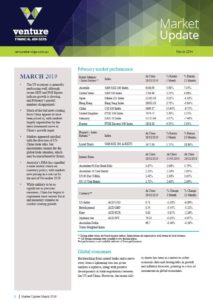The Pulse

- The US economy is generally performing well, although recent GDP and PMI figures indicate growth is slowing, and February’s payroll numbers disappointed.
- Much of the bad news coming from China appears to have been priced in, with markets largely unperturbed by the latest downward move in China’s growth target.
- Markets appeared satisfied with the direction of US-China trade talks, but uncertainties remain for the global trade situation, which may be exacerbated by Brexit.
- Australia’s RBA has signalled a more neutral stance on monetary policy, with markets now pricing in a rate cut by the end of November 2019.
- While unlikely to be as significant as previous measures, China has begun to implement more serious fiscal and monetary stimulus to combat slowing growth.
Australia
The most significant development in Australia over the past month has been the RBA’s shift in its policy bias from tightening to a neutral stance. Underpinning the change was a downgrade to the RBA’s growth forecasts, with GDP growth revised down to 3.0% in 2019 and 2.75% in 2020, while inflation is projected to be 2.0% for 2019 (down from 2.25%) before moving to 2.25% in 2020.
Global economies
Backtracking from central banks and a move away from a tightening bias has given markets a reprieve, along with positive developments in trade negotiations between the US and China. However, the recent rally in shares has been in contrast to softer economic data and downgrades in growth and inflation forecasts, pointing to a loss of momentum in global economies.
US
An apparent 180-degree shift in the Fed’s thinking since the end of 2018 has markets believing that the Fed is done hiking rates for this cycle and that the next move is likely to be down.
Europe
Eurozone GDP grew 1.1% year-on-year in the December quarter according to revised data, down from 1.6% in the September quarter, and has fallen from its recent peak of 2.8% over the year to September 2017.
China
The rate of Chinese growth, already at a 28-year low, continued to slow in the early part of 2019. China’s Premier Li Keqiang announced a cut to the country’s economic growth target for 2019 to 6.0–6.5%, down on 2018’s target of 6.6% and the slowest pace since 1990.
Asia Region
Japan’s GDP growth for the December quarter was 0.5%, or an annualised 1.9%, better than the initial estimate had suggested and allowing Japan to avoid a technical recession following a contraction of 0.7% in the previous quarter.